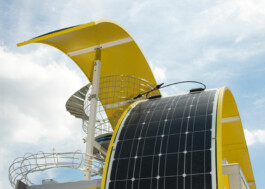


The “Solar Energy Kiosk” is converting one form of energy (sunlight) into a more visible one (juice). It depends on the weather condition however, how soon visitors can expect their share.
Commissioned by:
Nieuwe Instituut Rotterdam with curator Matylda Krzykowski
Sunshine is intuitively associated with energy, but its fluctuating nature makes it hard to grasp the potential. This disconnect may contribute to gaps between governmental energy strategies and public engagement.
This project, commissioned by Nieuwe Instituut Rotterdam for “The Energy Show” exhibition, aims to bridge this gap. It envisions a traveling kiosk that both visualizes solar energy and serves as a place for social gathering, fostering discussions about what solar-powered futures could look and feel like.
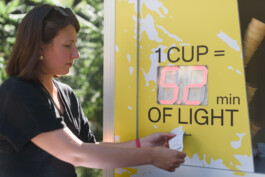
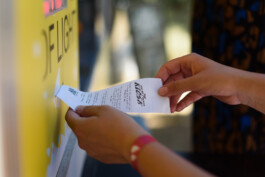

Minutes per cup display translates sunlight intensity into minutes needed to charge for the next serving.
Visitors receive a printed souvenir with their waiting time, including local weather data and energy-saving tips.
Solar ideas display: A vitrine showcases visitor-submitted solar ideas, creating a traveling mini-exhibition.
The “Solar Energy Kiosk” invites visitors to experience different qualities of sunlight: photovoltaic panels on its top are used to collect solar energy, powering an orange juicer. The more sun, the faster new oranges roll down the track, and the more frequently the juicer switches on.
How many minutes of sunlight did your cup of orange juice consume? The value can reach between less than 2 minutes of sunlight per cup at bright noon, to almost 60 minutes at sunset.
In return for the free orange juice, visitors were invited to submit a “solar idea”. This could be anything from a drawing, a written note, a poem, an object, a song or a sketch.
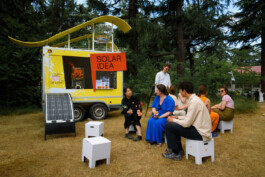
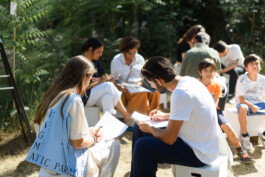

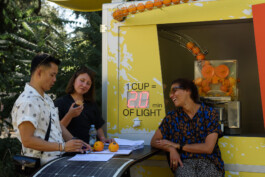
A trailer was transformed by adding modular extensions to its exterior: Two rows of curved photovoltaic panels adorn the top, making the solar energy generation visible even from far. Also high above, a metal basket holds enough oranges for a day. The more sun reaches the kiosk, the more frequently fruits are released by a custom produced revolver mechanism and roll down a rail to be pressed into juice. Turning sunlight into orange juice not only visualises the flow (and storage) of energy, but also provides energy to visitors in the form of kilocalories.

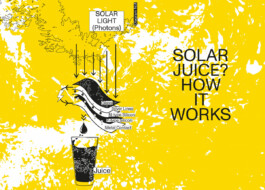

We actively supported the production of the kiosk e.g. through mechatronic experiments and modifications.
Graphic design: Studio Noviki’s solar-flare-inspired graphics include a diagram explaining solar panel technology.
Behind-the-scenes of the kiosk production process.
The Solar Energy Kiosk generated enthusiastic curiosity during its debut at Fuorisalone Milan Design Week 2022. Seeing oranges rolling down the rail in the context of the kiosk's other elements, many visitors instinctively connected the dots between the sun and juice and joined a lively discussion.
The many “Solar Ideas” submitted by visitors ranged from including solar panels on wind turbine blades and shade-providing solar roofs for charging electric cars. From these submissions, a selection was eventually exhibited as part of “The Energy Show” that took place at Nieuwe Instituut Rotterdam (September 2022 - March 2023). Originally planned for one year, the Solar Energy Kiosk proves its robustness and urgency time and time again and continues to tickle the imagination of solar visions.
YEAR
2022
LOCATIONS
Milan Design Week (IT), Nieuwe Instituut (NL), Fondation d'entreprise Martell (FR), Ornamenta (DE), ROEF Festival (NL)
DESIGN TEAM
Jonas Althaus, Martina Huynh
RESPONSIBILITIES
Concept, Product Design, Interaction Design, Production
COLLABORATORS
Pim Swinkels (electrical engineering), Paul Slot (metalwork), noviki (graphic design)
PHOTOGRAPHER
Isa de Jong, Giulia Virgara, Mattia Parodi, Aad Hoogendoorn



The “Solar Energy Kiosk” is converting one form of energy (sunlight) into a more visible one (juice). It depends on the weather condition however, how soon visitors can expect their share.
Commissioned by:
Nieuwe Instituut Rotterdam with curator Matylda Krzykowski
Sunshine is intuitively associated with energy, but its fluctuating nature makes it hard to grasp the potential. This disconnect may contribute to gaps between governmental energy strategies and public engagement.
This project, commissioned by Nieuwe Instituut Rotterdam for “The Energy Show” exhibition, aims to bridge this gap. It envisions a traveling kiosk that both visualizes solar energy and serves as a place for social gathering, fostering discussions about what solar-powered futures could look and feel like.



Minutes per cup display translates sunlight intensity into minutes needed to charge for the next serving.
Visitors receive a printed souvenir with their waiting time, including local weather data and energy-saving tips.
Solar ideas display: A vitrine showcases visitor-submitted solar ideas, creating a traveling mini-exhibition.
The “Solar Energy Kiosk” invites visitors to experience different qualities of sunlight: photovoltaic panels on its top are used to collect solar energy, powering an orange juicer. The more sun, the faster new oranges roll down the track, and the more frequently the juicer switches on.
How many minutes of sunlight did your cup of orange juice consume? The value can reach between less than 2 minutes of sunlight per cup at bright noon, to almost 60 minutes at sunset.
In return for the free orange juice, visitors were invited to submit a “solar idea”. This could be anything from a drawing, a written note, a poem, an object, a song or a sketch.




A trailer was transformed by adding modular extensions to its exterior: Two rows of curved photovoltaic panels adorn the top, making the solar energy generation visible even from far. Also high above, a metal basket holds enough oranges for a day. The more sun reaches the kiosk, the more frequently fruits are released by a custom produced revolver mechanism and roll down a rail to be pressed into juice. Turning sunlight into orange juice not only visualises the flow (and storage) of energy, but also provides energy to visitors in the form of kilocalories.



We actively supported the production of the kiosk e.g. through mechatronic experiments and modifications.
Graphic design: Studio Noviki’s solar-flare-inspired graphics include a diagram explaining solar panel technology.
Behind-the-scenes of the kiosk production process.
The Solar Energy Kiosk generated enthusiastic curiosity during its debut at Fuorisalone Milan Design Week 2022. Seeing oranges rolling down the rail in the context of the kiosk's other elements, many visitors instinctively connected the dots between the sun and juice and joined a lively discussion.
The many “Solar Ideas” submitted by visitors ranged from including solar panels on wind turbine blades and shade-providing solar roofs for charging electric cars. From these submissions, a selection was eventually exhibited as part of “The Energy Show” that took place at Nieuwe Instituut Rotterdam (September 2022 - March 2023). Originally planned for one year, the Solar Energy Kiosk proves its robustness and urgency time and time again and continues to tickle the imagination of solar visions.
PROJECT TYPE
Commission
YEAR
2022
LOCATIONS
Milan Design Week (IT), Nieuwe Instituut (NL), Fondation d'entreprise Martell (FR), Ornamenta (DE), ROEF Festival (NL)
DESIGN TEAM
Jonas Althaus, Martina Huynh
RESPONSIBILITIES
Concept, Product Design, Interaction Design, Production
COLLABORATORS
Pim Swinkels (electrical engineering), Paul Slot (metalwork), noviki (graphic design)
PHOTOGRAPHER
Isa de Jong, Giulia Virgara, Mattia Parodi, Aad Hoogendoorn